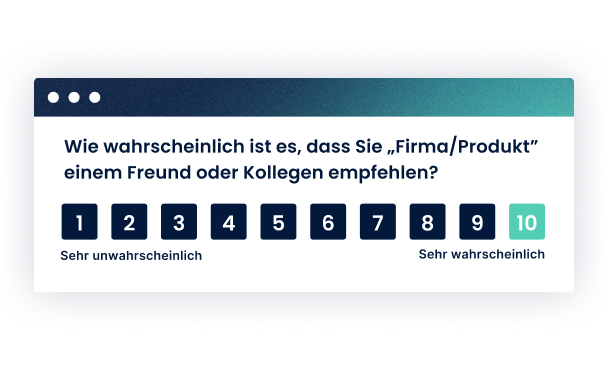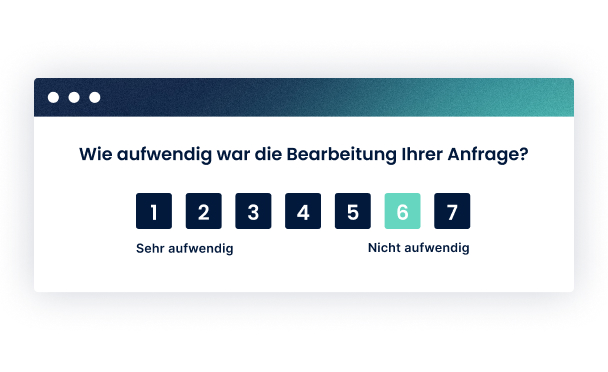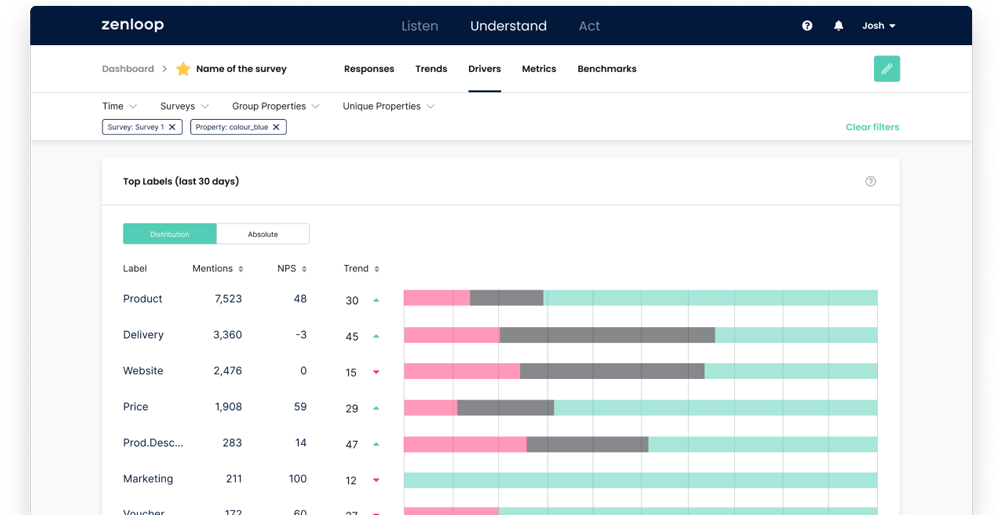Measuring Customer Satisfaction
The Most Important Customer Satisfaction KPIs
Many companies’ internal guidelines claim to have customer satisfaction as their highest goal. But how do you know if the measurements and strategies used actually bring success? Is it enough to take annual sales figures as proof of satisfied customers? Perhaps you should look at the volume of repeat purchases? Or maybe it has to do with the number of positive online reviews and what your customers are suggesting for improvements?
To determine customer satisfaction, companies should ask those who can provide them with the best-fitting information: the customers themselves. Therefore, it is advisable to look at customer satisfaction surveys and decide how they can be used. But what do you do with this flood of data? Of course, all this data needs evaluation and this is exactly where customer satisfaction KPIs come in.
What Are KPIs?
First and foremost, KPIs (Key Performance Indicators) are used to support easier and faster decision-making. Their meaningful results mean they can also be used to control and check any strategies you choose to implement. Another important point is their role as an early warning system—thanks to their relevance, downtrends can be detected easier and faster and thus counteracted as soon as they arise.
Key figures are quantifiable metrics that make a particular topic such as customer satisfaction objectively measurable. Information is therefore expressed in the form of numbers that are used in the context of a company to make comparisons, for example. You could also call these key figures benchmarks. Specific characteristics of key figures include the following aspects:
- Representativeness
- Meaningfulness
- Target orientation
- Economic viability
- Reversibility
- Functionality
Preparing to Measure Customer Satisfaction
You would like to ask your customers about their attitude towards your company, brand, or product. So far, so good. Before simply sending out an email with a questionnaire, you should consider a few things in order to optimize the customer survey in advance. First of all, it is necessary for as many customers as possible to participate. It is therefore advisable to increase the acceptance of the measures by announcing them. Here you should remember that you are certainly not the only company that sends surveys to its customers. However, you go unnoticed in the multitude of email surveys and newsletters. Accordingly, you should personalize your email with a small appropriate thank you, such as a discount for the next purchase of a frequently bought product.
It is important for your company to determine what exactly you want to measure with the survey in advance. It is also recommended to make sure that this measurement is not the only data collected. Rather, the results have to show how well the strategies implemented are being adopted and where there is room for improvement. Because it is only in this way that you can start with data and the survey results do not end up under “good to know” in the filing cabinet.
Key Customer Satisfaction Metrics
Although customer satisfaction plays an important role, many companies still find it difficult to measure the satisfaction of their customers. Suitable key figures are therefore a good way to get an overview of the current state and development. The three most widely used key metrics are outlined below. However, in our customer satisfaction guide, we also explain other possible questions for determining customer satisfaction.
Customer Satisfaction Score: Satisfaction with the Product
The Customer Satisfaction Score (CSAT) reflects satisfaction with the product or service received. This score is determined based on the following question:
How do you rate your overall satisfaction with the service/goods received?
Respondents can answer on a scale that usually ranges from one to five. Smaller scales such as one to three or larger ones such as one to ten are also used in some cases. In the example with a scale of one to five, one stands for extremely dissatisfied and five is very satisfied. Customers who leave a rating of four or five are considered satisfied. The formula for calculating the CSAT is:
Satisfied respondents ÷ sum of all respondents x 100 = CSAT in percent
The CSAT is often used to ask customers for a review right after their purchase. Therefore, this metric always refers to the present. It is used to ask about specific products or services, meaning that satisfaction in other areas can look completely different. It is therefore important to consider the Customer Satisfaction Score only as part of the big picture and to best use it as a bundled strategy along with other metrics. The Customer Satisfaction Score is, for example, the perfect way to get a first impression of the state of customer satisfaction, which can then be deepened and expanded with other metrics.

Net Promoter Score®: Recommendation—Yes or No?
As one of the most important values, the Net Promoter Score (NPS®) provides a statement of consumers’ willingness to recommend the respective company, brand, or product to friends, family, and acquaintances. This willingness to recommend is a significant indication of the respondents’ satisfaction. In principle, only satisfied customers recommend a product to people who are close to them. It is precisely this readiness that a company can record with the NPS.
As with CSAT, a customer satisfaction survey is used for this purpose. To determine this score, a quick and simple question is enough:
How likely is it that you would recommend Company X to your friends or acquaintances?
Here, too, the answer is given on a scale ranging from zero to ten. Based on the answer, respondents are divided into three groups: Detractors, Passives, and Promoters. The passives are sorted out for calculation and only promoters and detractors are taken into account. The NPS is the result of the proportion of promoters minus the proportion of detractors. It is calculated how many percent the two groups each represent. The numbers are then used in this formula:
Percent promoters – percent detractors = NPS
Because of this formula, the NPS must always be between -100 and +100. The higher the value is, the more satisfied customers are.
This score also offers respondents the opportunity to express their own opinion in writing using a free text field. This feedback can be evaluated and used with appropriate software to initiate improvements or forward satisfied customers to rating portals. This is especially useful because they attract interested parties and potential new customers who research credible valuations and use them to make their purchase decisions.
Since the NPS represents both the overall picture and partial acceptance at a specific touchpoint, it is considered one of the most important metrics of customer satisfaction. Thanks to optimal software, the NPS can be evaluated quickly and easily. Therefore, this score should definitely have a firm place in your own strategy.
Related:

Customer Effort Score: Effort with the Transaction
The Customer Effort Score (CES) determines how straightforward it was to interact with the company. It is therefore queried directly after the said interaction, such as a conversation with customer service. The CES can be calculated in two different ways: average and NPS-style. The following applies to both variants: the higher the value, the greater the effort is.
The average grade is calculated as follows:
Sum of values ÷ Number of respondents = CES
For NPS-style calculation, customers are divided into three categories: a value of one to two means low effort, three to four medium effort, and five to seven high effort. Then you calculate the CES using the formula:
Percentage of high effort – percentage of low effort = CES in percent
CES is based on the assumption that customer satisfaction is not the result of a particularly spectacular experience, but rather through uncomplicated and smooth interaction. It is therefore seen as a very meaningful metric for customer satisfaction and customer loyalty. It should also be noted in this case that the score does not provide insights into general customer satisfaction but rather about a particular interaction or product, similar to CSAT.
For calculating NPS-style scores, you can use our free NPS calculator for quick and accurate results.

Why Measure Customer Satisfaction?
Customer satisfaction plays a crucial role in the company’s success, which is particularly noticeable in two ways. On the one hand, satisfied customers will continue to buy from a company—often in increasing quantities—while the vast majority of dissatisfied customers do not buy there again. On the other hand, customers who are satisfied with a product or company often recommend it to the circle of friends and families, which allows additional customers to be acquired by the company without any effort.
It is therefore important to have an overview of customer satisfaction. Some certainly refer back to the well-known channels, such as rating portals or social media. And it is true, here you get to read reviews from buyers again and again. However, if you only rely on ratings to assess customer satisfaction, you take a dangerous path. Because one thing about customer satisfaction can put a spanner in the works: Studies show that, in most cases, dissatisfied customers simply leave—no complaint, no negative criticism; they are just gone. Before that happens, the company must already know how satisfied the customers are and where there is potential for improvement. This explains precisely why a company has to measure customer satisfaction. Specified key figures such as the above-mentioned CSAT, NPS, and CES are therefore ideal to help do so easily and quickly and also to ensure their meaningful value.
Three Good Reasons to Use KPIs
Anyone who has not worked with these figures before may wonder what makes the metrics an effective tool for measuring customer satisfaction and why you should place trust in the metrics. This can be answered by means of three keywords:
Simplify: As can be seen from the previous definition, the underlying data obtained from, for example, the survey of customers is simplified by the key figures and merged into one value. Using the example of the customer survey, means not all responses need to be evaluated in a meaningful way, as the key figures can be representative of the content of the responses. The answers can be summarized by means of the key figure, simplifying analysis.
Condense: Since different values are usually merged into a key figure, the data set is automatically condensed. This reduction also allows you to keep an eye on values for a longer period of time without becoming confusing. Ideally, key metrics help to understand important data more quickly and to be able to interpret it.
Specify: Simplified presentation and precise answers? This is not a contradiction, because key figures are carefully shaped from different numbers. In doing so, the underlying formula must be able to withstand an economic test. If this is the case, key figures help to interpret certain changes quickly and thus formulate precise recommendations for action.
Summing up
KPIs play a major role both in customer satisfaction and in evaluating and optimizing your strategies. If you should still ask yourself why it is important to measure customer satisfaction, you should clearly consider one thing: Measuring customer satisfaction can determine the success of your company. Why this is so, is plainly evident when looking at the methods. Each of the three techniques presented has its own specific field of application. Only when one knows, on the basis of a sophisticated survey, how high or even low customer satisfaction in these areas is, can one proceed accordingly. To ensure that you do not fall in a flood of numbers, you should also constantly question, adjust and optimize the use and purpose of the key figures. This is because they must reflect the company’s individual goal, its mission statement, and its visions in order to make a sound and meaningful statement possible.
Measure satisfaction with zenloop






